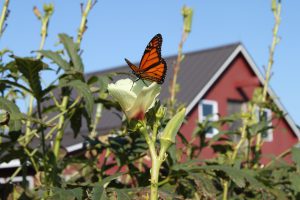
This morning I read a fascinating article on plants that I would like to share some thoughts on. It was a study on bean plants and their reactions to a predator – aphids. We have long known that plants under attack from pests communicate to each other and the non-infected plants are able to mount their defenses to prepare for the spread of either disease or predators. But we have not understood how that communication worked. Most researchers assumed it was chemical – that distressed plants exuded a chemical signal that the other plants around it picked up and reacted to. Dr. David Johnson of Aberdeen University was focusing on the roles of fungal networks that naturally surround plants grown in undisturbed soil. In their natural state, these networks and their plants live symbiotically. As you may know, plants give energy to the fungi in the form of carbohydrates that the plants form from sunlight with photosynthesis . For that stored energy, the fungi exchange needed nutrients and elements that plants cannot acquire on their own. Both species need each other for their success. Dr. Johnson separated the plants from each other with plastic bags that were designed to prevent any airborne chemical transfer. He also surrounded some plants with mesh rings that prevented any root contact since the holes were too small for roots of the plants but large enough to be penetrated by fungal networks. Finally he surrounded some plants with mesh that he rotated, breaking off the fungal networks. He then infected the center plant in each group with aphids and watched what happens. The infected bean plants began producing a battery of chemicals that repel aphids. They also produced other chemicals that attract small wasps that are aphid predators. Pretty slick. What was interesting though was how the surrounding plants reacted. If the plant had a fungal network connection with the infected plant, it began producing the same defensive chemicals. But plants with no fungal network connection remained fully vulnerable and attractive to aphids. In other words, the fungal network communicated the threat between the plants. It makes sense does it not? Those fungal networks depend on healthy leaves in the sunlight. Insect pests represent a threat to the plant but also to the fungal network below. So that communication is in the best interest too of the fungi.
There are two conclusions that I want you to draw from this research. One is the valuable insight that our natural world is so complex and so little understood that we all need to approach this stuff with a lot of humility. But the other is how important all these interconnections are between the visible world of plants and the invisible subterranean complex underneath that is the source of healthy growth. On our farm we have a number of strange practices in our growing methods. One that mystifies many is why we do so little tilling of the soil. We prefer mulching in everything and hand pulling weeds to tilling and cultivating mechanically. It is not a perfect system. Sometimes the crab grass gets the better of us and we have to till it under just to keep going. But generally we move from crop to crop without tilling. The reason is our belief that it makes a difference in the quality of our product. All those fungal networks and bacterial rhizomes take time to establish around a root system. They react poorly to chemicals and particularly to soil disruption. As that new research seems to show, the fungal network helps plants defend themselves. But as important to our operation as that is, I believe our minimally invasive methods lead to better nutrition for our customers. All that microfauna make an elemental smorgasbord available for the plant’s roots. When the plant has maximum access to the parade of nutrients and elements that rich soil contains, and when the plant is producing in a healthy, lower stress environment, I think it produces the best food for us. So I minimize my tilling and hope that you can taste the difference these practices make in our vegetables. It is more work and more costly in labor. I cannot prove to you that it makes a big difference. But I think you can judge much of this on taste and how eating this food makes you feel. The rest, as they say, we just take on faith.
Thanks for all your support. Here’s to your good health and good eating.
Cricket.

